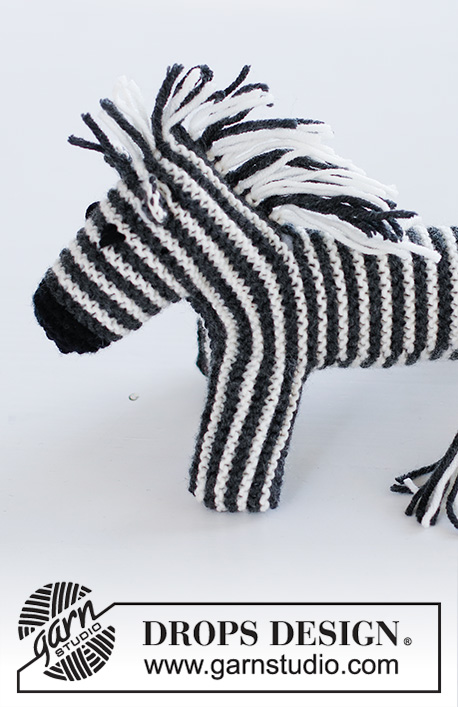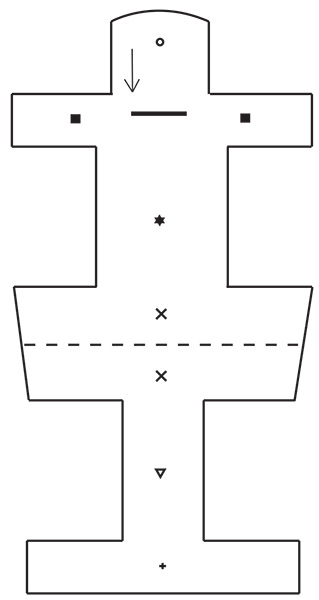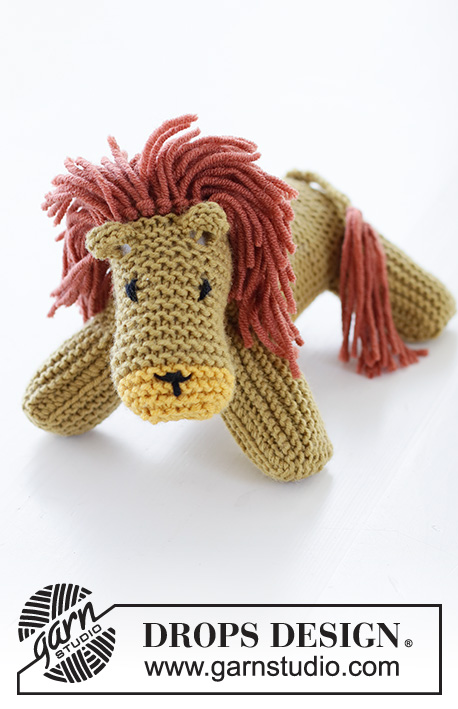Comments / Questions (5)
![]() Nicole Heimer wrote:
Nicole Heimer wrote:
Merci bien pour les explications très claires.je ne suis pas très douée et j ai réussi sans problème 👏
17.01.2022 - 17:42
![]() Cécile Herrier wrote:
Cécile Herrier wrote:
Bonjour, je suis bloquée le zébre Orea the zebra. Je me retrouve avec un trou, pourriez-vous ou aurait il une vidéo pour monter plusieurs mailles sur ce modèle car je suis perdue, et j'ai un doute. Je trouve des vidéos mais je une 1 ou 2 mailles pas pour 8 mailles . Merci beaucoup. C'est pour 2 jumeaux qui sont nés grands prématurés. Merci Cécile Herrier
07.11.2021 - 09:29DROPS Design answered:
Bonjour Mme Herrier, vous parlez des 8 m montées pour les oreilles? Elles vont effectivement former un petit trou, car ces mailles sont montées entre les 35 m tricotés au début du rang et les 5 m endroit du dessus de la tête pour la 1ère et entre ces 5 m endroit et les 35 dernières mailles. On le devine un peu sur la 3ème photo. Bon tricot!
08.11.2021 - 07:36
![]() Marilyn wrote:
Marilyn wrote:
I have done the head in "stripes" but as I cast on for the front legs I don't know where to change colours. If I cast on at the end of first row of colour A then the other 23 casts on at the end of row two then I have a full ridge on part of that row but not on the remainder . Do I do more than one ridge before adding in colour B? Where does Colour B start ? at Underarm or foot?
24.01.2021 - 20:04DROPS Design answered:
Dear Marilyn, just make sure there will be always 1 ridge each colour over the middle stitches if you are not sure anymore, and then choose the colour it should. To make it easier, you can cast on the stitches at the end of the WS row with the colour you will need to work the next row. Happy knitting!
25.01.2021 - 10:46
![]() Alissant wrote:
Alissant wrote:
Comment cousez-vous le museau du zèbre ???
19.01.2021 - 19:01DROPS Design answered:
Bonjour Mme Alissant, pliez la tête en double, et faites la couture sous la tête et assemblez les mailles de montage entre elles pour le museau. Bon assemblage!
20.01.2021 - 07:29
![]() Alissant wrote:
Alissant wrote:
Comment finir la tete pour la couture? (Merci pour tous vos modèles)
19.01.2021 - 18:56
Oreo the Zebra#dropsoreothezebra |
||||||||||||||||||||||||||||
 |
 |
|||||||||||||||||||||||||||
Knitted zebra in garter stitch and stripes in DROPS Merino Extra Fine.
DROPS Children 37-19 |
||||||||||||||||||||||||||||
|
------------------------------------------------------- EXPLANATION FOR THE PATTERN: ------------------------------------------------------- GARTER STITCH (back and forth): 1 ridge = knit 2 rows. STRIPES: Work 1 ridge with dark grey. Work 1 ridge with off white. Repeat these 2 ridges until finished measurements. ------------------------------------------------------- START THE PIECE HERE: ------------------------------------------------------- ZEBRA - SHORT OVERVIEW OF THE PIECE: Work piece back and forth on circular needle. Work the zebra in 1 part. Work upper part of zebra from the head to the back side and then work the under part of zebra from the back side and to the head. Sew together along each side and on the underside of head. HEAD: Cast on 12 stitches on circular needle size 3 mm with black. Knit 1 row. On next row increase stitches as follows: * Knit 1, 1 yarn over *, work from *-* until 1 stitch remains, finish with knit 1 = 23 stitches. Knit yarn overs twisted on next row to avoid holes! Work back and forth in GARTER STITCH - read explanation above. When 3 ridges have been worked, continue in STRIPES - read explanation above. REMEMBER THE KNITTING TENSION! FRONT LEGS (over): When piece measures 5 cm, cast on 21 stitches at the end of the next 2 rows for front legs (i.e. in each side of piece) = 65 stitches. Work 1 ridge. On next row increase stitches as follows: Knit 14, * knit 1, 1 yarn over *, work from *-* 5 times in total, knit 27, * knit 1, 1 yarn over *, work from *-* 5 times in total and finish with knit 14 = 75 stitches. Knit yarn overs twisted on next row to avoid holes! EARS: When 2 ridges have been worked from where stitches for front legs were cast on, cast on stitches for ears as follows: Knit 35, cast on 8 stitches for ear, knit 5, cast on 8 stitches for ear and knit the last 35 = 91 stitches. Knit 1 row from wrong side. On next row from right side, cast off stitches for ear as follows: Knit 35, cast off 8 stitches, knit 5, cast off 8 stitches and knit the last 35 = 75 stitches. Work back and forth over these stitches until piece measures 4 cm from where stitches were cast on for legs. On next row from right side, cast off stitches for head and hind legs as follows: Cast off the first 14 stitches for front legs, knit 10, cast off the next 27 stitches for head, knit the last 24 stitches = 34 stitches. On next row from wrong side cast off the first 14 stitches for front legs, knit 10, cast on 1 new stitch (in the middle of back), knit the last 10 = 21 stitches. BACK: Work back and forth in garter stitch and stripes until piece measures 8 cm from where stitches were cast off for front legs. HIND LEGS: At the end of the next 2 rows cast on 14 new stitches for hind legs (i.e. in each side of piece) = 49 stitches. Work back and forth in garter stitch until piece measures 4 cm from where stitches were cast on for hind legs. On next row from right side decrease stitches as follows: Knit 14, * knit 2 together *, work from *-* 10 times in total (= 10 stitches decreased), and finish with knit 15 = 39 stitches. Continue back and forth in garter stitch until piece measures 7½ cm from where stitches were cast on for hind legs, adjust so that next stripes is worked with same colour as stitches cast on for hind legs. At the beginning of the next 2 rows cast off 13 stitches for hind legs (i.e. in each side of piece) = 13 stitches remain for stomach. STOMACH: Continue back and forth in garter stitch until piece measures 8 cm from where stitches were cast off for hind legs, adjust to work same number of stripes worked on back (i.e. from where stitches were cast off for hind legs and cast on for hind legs on the back), and that next stripes is worked in same colour as stitches cast off for front legs. FRONT LEGS (under): At the end of the next 2 rows cast on 13 stitches = 39 stitches. Continue back and forth in garter stitch until piece measures 3½ cm from where stitches were cast on for front legs (under) Cast off by knitting. ASSEMBLY: Fold zebra double and sew together in the side, in outer loops of edge stitch/row. Fill the zebra with cotton wool and sew together behind in the back of neck in outer loops of edge row. Embroider eyes with black. MANE: Fasten mane mid on top of head in the neck. Fasten loops in a row along seam at the back of neck follows: Cut length of dark grey/off white of approx. 14 cm. Place them double, thread loop through 1 stitch. Then pull strands through loop and tighten. Fasten approx. 18 loops up along the seam and down the forehead of zebra, alternately dark grey and off white. Approx. 1 loop in every stitch. Then cut the tips so that they are the same length. TAIL: Cast on 20 stitches on circular needle size 3 mm with dark grey. Cast off with off white. Fasten tail on zebra. Cut 3 strands off white and 3 strands dark grey of approx. 14 cm, place the double, thread loop through tip of tail. Then pull strands through loop and tighten. Then cut the tips so that they are the same length. |
||||||||||||||||||||||||||||
Diagram explanations |
||||||||||||||||||||||||||||
|
||||||||||||||||||||||||||||

|
||||||||||||||||||||||||||||
Have you finished this pattern?Tag your pictures with #dropspattern #dropsoreothezebra or submit them to the #dropsfan gallery. Do you need help with this pattern?You'll find 15 tutorial videos, a Comments/Questions area and more by visiting the pattern on garnstudio.com. © 1982-2025 DROPS Design A/S. We reserve all rights. This document, including all its sub-sections, has copyrights. Read more about what you can do with our patterns at the bottom of each pattern on our site. |
||||||||||||||||||||||||||||



































































Post a comment to pattern DROPS Children 37-19
We would love to hear what you have to say about this pattern!
If you want to leave a question, please make sure you select the correct category in the form below, to speed up the answering process. Required fields are marked *.